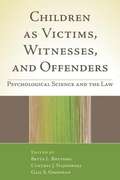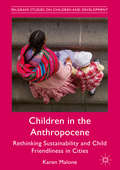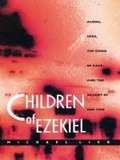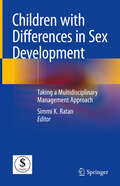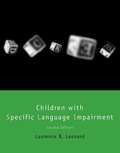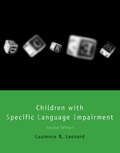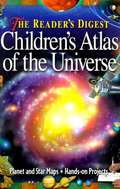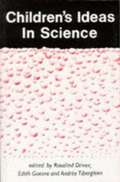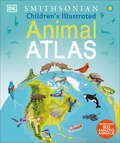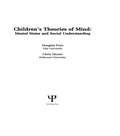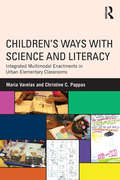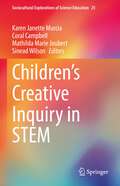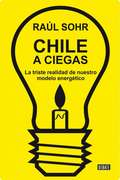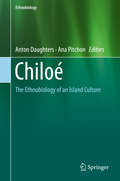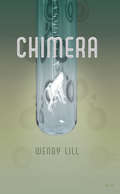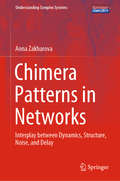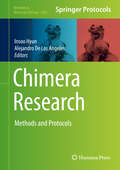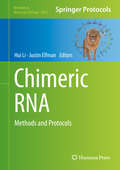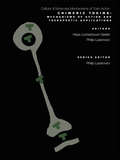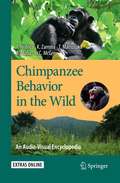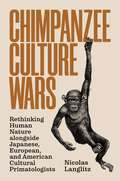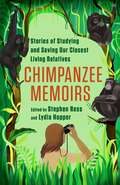- Table View
- List View
Children as Victims, Witnesses, and Offenders
by Bette Bottoms Cynthia NajdowskiGrounded in the latest clinical and developmental knowledge, this book brings together leading authorities to examine the critical issues that arise when children and adolescents become involved in the justice system. Chapters explore young people's capacities, competencies, and special vulnerabilities as victims, witnesses, and defendants. Key topics include the reliability of children's abuse disclosures, eyewitness testimony, interviews, and confessions; the evolving role of the expert witness; the psychological impact of trauma and of legal involvement; factors that shape jurors' perceptions of children; and what works in rehabilitating juvenile offenders. Policies and practices that are not supported by science are identified, and approaches to improving them are discussed.
Children in the Anthropocene: Rethinking Sustainability and Child Friendliness in Cities (Palgrave Studies on Children and Development)
by Karen MaloneThis book elaborates the need, in a rapidly urbanizing world, for recognition of the ecological communities we inhabit in cities and for the development of an ethics for all entities (human and non-human) in this context. Children and their entangled relations with the human and more-than-human world are located centrally to the research on cities in Bolivia and Kazakhstan, which investigates the future challenges of the Anthropocene. The author explores these relations by employing techniques of intra-action, diffraction and onto-ethnography in order to reveal the complexities of children's lives. These tools are supported by a theoretical framing that draws on posthumanist and new materialist literature. Through rich and complex stories of space-time-mattering in cities, this work connects children's voices with a host of others to address the question of what it means to be a child in the Anthropocene.
Children of Ezekiel: Aliens, UFOs, the Crisis of Race, and the Advent of End Time
by Michael LiebAre Milton's Paradise Lost, Ronald Reagan's "Star Wars" missile defense program, our culture's fascination with UFOs and alien abductions, and Louis Farrakhan's views on racial Armageddon somehow linked? In Children of Ezekiel Michael Lieb reveals the connections between these phenomena and the way culture has persistently related the divine to the technological. In a work of special interest at the approach of the millennium, Lieb traces these and other diverse cultural moments--all descended from the prophet Ezekiel's vision of a fiery divine chariot in the sky--from antiquity to the present, across high and low culture, to reveal the pervasive impact of this visionary experience on the modern world. Beginning with the merkabah chariot literature of Hebrew and Gnostic mysticism, Lieb shows how religiously inspired people concerned with annihilating their heretical enemies seized on Ezekiel's vision as revealing the technologically superior instrument of God's righteous anger. He describes how many who seek to know the unknowable that is the power of God conceive it in technological terms--and how that power is associated with political aims and a heralding of the end of time. For Milton, Ezekiel's chariot becomes the vehicle in which the Son of God does battle with the rebellious angels. In the modern age, it may take the form of a locomotive, tank, airplane, missile, or UFO. Technology itself is seen as a divine gift and an embodiment of God in the temporal world. As Lieb demonstrates, the impetus to produce modern technology arises not merely from the desire for profit or military might but also from religious-spiritual motives. Including discussions of conservative evangelical Christian movements, Reagan's ballistic shooting gallery in the sky, and the Nation of Islam's vision of the "mother plane" as the vehicle of retribution in the war against racial oppression, Children of Ezekiel will enthrall readers who have been captivated, either through religious belief or intellectual interests, by a common thread uniting millennial religious beliefs, racial conflict, and political and militaristic aspirations.
Children with Differences in Sex Development: Taking a Multidisciplinary Management Approach
by Simmi K. RatanThis manual covers all possible aspects of managing a child with differences in sex development, an entity easily missed by the unsuspecting clinician. Managing such children is challenging due to various processes (genetic, hormonal, environmental, chromosomal, and environmental) involved in developing gonads and brain imprinting. The entity of Gender dysphoria adds further to this complexity. With a global uproar caused by the cropping up of medicolegal issues concerning sex allotment and sex of rearing, a need is felt to know about the line of approach to address the problems of management of these children, which does not stop at medical and surgical treatment. Whereas many social and legal organizations are relentlessly working for the cause of such children, there is a lack of comprehensive literature on the round management of such children, which makes the book more of an essential addition to the existing reading material. Esteemed writers give all these aspects and explain lucidly with the help of tables, figures, and diagrams.
Children with Specific Language Impairment
by Laurence B. LeonardChildren with specific language impairment (SLI) show a significant deficit in spoken language that cannot be attributed to neurological damage, hearing impairment, or intellectual disability. More prevalent than autism and at least as prevalent as dyslexia, SLI affects approximately seven percent of all children; it is longstanding, with adverse effects on academic, social, and (eventually) economic standing. The first edition of this work established Children with Specific Language Impairment as the landmark reference on this condition, considering not only the disorder's history, possible origins, and treatment but also what SLI might tell us about language organization and development in general. This second edition offers a complete update of the earlier volume. Much of the second edition is completely new, reflecting findings and interpretations based on the hundreds of studies that have appeared since the publication of the first edition in 1997. Topics include linguistic details (descriptive and theoretical), word and sentence processing findings, genetics, neurobiology, treatment, and comparisons to such conditions as autism spectrum disorders, ADHD, and dyslexia. The book covers SLI in children who speak a wide range of languages, and, although the emphasis is on children, it also includes studies of adults who were diagnosed with SLI as children or are the parents of children with SLI. Written by a leading scholar in the field, Children with Specific Language Impairment offers the most comprehensive, balanced, and unified treatment of SLI available.
Children with Specific Language Impairment (Language, Speech, and Communication)
by Laurence B. LeonardThe landmark reference in the field, completely updated: a comprehensive treatment of a disorder that is more prevalent than autism. Children with specific language impairment (SLI) show a significant deficit in spoken language that cannot be attributed to neurological damage, hearing impairment, or intellectual disability. More prevalent than autism and at least as prevalent as dyslexia, SLI affects approximately seven percent of all children; it is longstanding, with adverse effects on academic, social, and (eventually) economic standing. The first edition of this work established Children with Specific Language Impairment as the landmark reference on this condition, considering not only the disorder's history, possible origins, and treatment but also what SLI might tell us about language organization and development in general. This second edition offers a complete update of the earlier volume.Much of the second edition is completely new, reflecting findings and interpretations based on the hundreds of studies that have appeared since the publication of the first edition in 1997. Topics include linguistic details (descriptive and theoretical), word and sentence processing findings, genetics, neurobiology, treatment, and comparisons to such conditions as autism spectrum disorders, ADHD, and dyslexia. The book covers SLI in children who speak a wide range of languages, and, although the emphasis is on children, it also includes studies of adults who were diagnosed with SLI as children or are the parents of children with SLI.Written by a leading scholar in the field, Children with Specific Language Impairment offers the most comprehensive, balanced, and unified treatment of SLI available.
Children's Atlas of the Universe
by Reader'S DigestThe Reader's Digest Children's Atlas of the Universe will revolutionize the way kids learn about the stars. Combining spectacular color art (including maps of the planets) and hundreds of photographic images from space missions and telescopes, the atlas tells the story of the universe as it has never been told before. Every page is a storehouse of riveting, up-to-the minute information. Introductory sections cover Earth's place in space, the history of astronomy and space exploration, and modern observatories and space travel. The atlas then visits each of the planets of our solar system in turn, along with asteroids, comets, and meteors, before proceeding to the stars and galaxies of deep space. Included are detailed star charts for both Northern and Southern Hemisphere stargazers, a universe fact file, a glossary, and an index. Activities and projects provide a hands-on approach to understanding the principles of astronomy. The Reader's Digest Children's Atlas of the Universe continues the high standard in children's reference publishing established by The Reader's Digest Children's Atlas of the World. For children of all ages, this beautifully produced volume is the ultimate resource for learning about the mysteries of the universe.
Children's Ideas in Science
by Rosalind Driver Edith Guesne Andrée TiberghienChildren arrive in their science classrooms with their own ideas and interpretations of the phenomena they are to study even when they have received no systematic instruction in these subjects whatsoever. These ideas and interpretations are a natural result of everyday experience - of practical physical activities, of talking with other people, and of the media. This book documents and explores the ideas of school students (aged 10-16) about a range of natural phenomena such as light, heat, force and motion, the structure of matter and electricity. It also examines how students' conceptions change and develop with teaching. The editors have brought together science educators who come from different parts of the work but whose work is focused on the same determination to bring insight into the conceptual world of children in science classrooms - insight which will be helpful in making science teaching and learning more rewarding for teachers and children alike.
Children's Illustrated Animal Atlas (Children's Illustrated Atlas)
by DKBring the amazing animal kingdom right into your home! Packed with fun facts about animals and more than 40 full-color maps that detail the countries where they live.This fabulous educational book for kids zooms-in on countries and continents to show key animal habitats and locations around the world. A thrilling animal adventure around the globe, perfect for kids ages 6–8.Each colorful map in this children's book is bursting with animal facts, combining illustrations with gorgeous photographs that highlight each continent's most iconic animals. From the tallest mountains and desolate deserts to wild grasslands and tropical rain forests; it covers key habitats and locations for each country.Packed with tons of fun facts and figures, the Children's Illustrated Animal Atlas explains where these hidden habitats are found and what the local climate is like. Find descriptions and illustrations of the plants and animals that live in them, making the information easy for kids to comprehend.This children's atlas also includes a super awesome, colorful world map pull-out poster showing every corner of the world and animals that live in each country. Through this educational atlas, children are shown how to read a map, use a map key, follow a compass, and how to judge scale and distance.Charming and informative, this kids' atlas is a delightful addition to every child's library.Take A Thrilling Animal Adventure Around The Globe!An enchanting atlas, packed full of fascinating facts and more than 600 incredible animals. From polar bears in the frozen north to thorny devils in the Australian outback and to toucans in the Amazon rain forest, this fact book will bring the world of Earth's wildlife right into your home!Some of the amazing animals you can expect to encounter: - Emu - Australia's largest bird- Giant hummingbird - the biggest of its kind in the whole world- Cheetah - the world's fastest land animal- Ploughshare tortoise - males try to flip each other over during fights (talk about fighting dirty!)- And much, much more!The Children's Illustrated series brings a whole host of educational subjects and general knowledge to life in full living color. Detailed drawn pictures, photographs, and images teach your child about History, Language, Geography, and more. Get a copy of the Children's Illustrated Animal Atlas or any of the other wonderful titles and start your collection.
Children's Theories of Mind: Mental States and Social Understanding
by Chris Moore Douglas FryeThis book is a result of a study group that met to discuss the child's theory of mind. A topic whose effects span cognitive, language, and social development, it may bring a unifying influence to developmental psychology. New studies in this area acknowledge children's conceptions of intention and belief, as well as intention and belief themselves, and consider the explanations they provide for children's developing abilities. The contributors to this important volume examine several aspects of the child's theory of mind, and present significant research findings on the theory itself and how it changes and develops for each child. Discussions of the utility of a theory of mind to the child, and to developmental psychologists trying to understand children, are provided. Finally, new explanations are offered for how children acquire a theory of mind in the first place.
Children's Ways with Science and Literacy: Integrated Multimodal Enactments in Urban Elementary Classrooms
by Christine C. Pappas Maria VarelasScience is often a forgotten subject in early elementary grades as various mandates require teachers to focus on teaching young students to achieve specific reading and mathematical competencies. This book offers specific examples and empirical evidence of how integrated science-literacy curriculum and teaching in urban primary-grade classrooms give students opportunities to learn science and to develop positive images of themselves as scientists. The Integrated Science-Literacy Enactments (ISLE) approach builds on multimodal, multidimensional, and dialogically oriented teaching and learning principles. Readers see how, as children engage with texts, material objects, dialogue, ideas, and symbols in their classroom community, they are helped to bridge their own understandings and ways with words and images with those of science. In doing so, they become learners of both science and literacy. The book features both researcher and teacher perspectives. It explores science learning and its intersection with literacy development in schools that educate predominately children of color, many of whom struggle with poverty and have been traditionally underestimated, underserved, and underrated in science classrooms. In all these ways, this volume is a significant contribution to a critically under-researched area of science education.
Children’s Creative Inquiry in STEM (Sociocultural Explorations of Science Education #25)
by Coral Campbell Karen Janette Murcia Mathilda Marie Joubert Sinead WilsonThis edited volume brings together international research that explores children’s creativity in STEM inquiry. It takes the position that creativity is relevant in all aspects of life and is essential for adaptable and innovative thinking. The research informed content of the book, highlights both challenges and opportunities for growing children’s creativity. The book focuses on fostering children’s creativity and natural curiosity in the world around them through STEM inquiry. Through STEM inquiry, children are learning through a cross- disciplinary approach where they apply concepts from multiple fields as they are thinking creatively, problem solving and constructing solutions. Educators play a critical role in encouraging children’s creativity by modelling creativity, providing creative projects for children and importantly, establishing rich culturally connected environments where children have the resources, conditions and opportunities for acting and thinking creatively. The book provides a lens for looking at children’s creativity in a range of different cultural settings. It offers insight and guidance to future research and will build educators’ capacity for developing children’s creative practices.
Chile a ciegas: La triste realidad de nuestro modelo energético
by Raúl SohrLa situación energética del país es preocupante. Es, de hecho, la mayor amenaza en el futuro previsible. Nada puede entrabar el desarrollo de Chile de una manera más comprometedora que la falta de recursos energéticos. Basta con apreciar el impacto del aumento de los precios de los combustibles fósiles. El enfoque de este libro es político. Aquí se descarta el fatalismo de quienes culpan al destino y dicen: «La naturaleza no nos dio petróleo». También se relativiza la fe en las soluciones técnicas que un gobierno tras otro -y el actual no es la excepción- ha buscado para mitigar las carencias energéticas. Ello en circunstancias que Chile tiene enormes recursos y no los ha desarrollado por las características del modelo económico vigente. Un libro imprescindible, profundamente informado, sobre por qué hemos llegado hasta este punto en que Chile parece avanzar a ciegas y qué podemos hacer de aquí en adelante. La situación energética del país es preocupante. Es, de hecho, la mayor amenaza en el futuro previsible. Nada puede entrabar el desarrollo de Chile de una manera más comprometedora que la falta de recursos energéticos. Basta con apreciar el impacto del aumento de los precios de los combustibles fósiles. El enfoque de este libro es político. Aquí se descarta el fatalismo de quienes culpan al destino y dicen: «La naturaleza no nos dio petróleo». También se relativiza la fe en las soluciones técnicas que un gobierno tras otro -y el actual no es la excepción- ha buscado para mitigar las carencias energéticas. Ello en circunstancias que Chile tiene enormes recursos y no los ha desarrollado por las características del modelo económico vigente. Un libro imprescindible, profundamente informado, sobre por qué hemos llegado hasta este punto en que Chile parece avanzar a ciegas y qué podemos hacer de aquí en adelante.
Chill Out! Science to Make You Shiver (Fountas & Pinnell LLI Gold #Level P)
by Becky FairbanksChill Out! Science to Make You Shiver Author: Becky Fairbanks
Chiloé: The Ethnobiology of an Island Culture (Ethnobiology)
by Anton Daughters Ana PitchonThis volume focuses on the ethnobiology of southern Chile’s Archipelago of Chiloé. Chiloé presents a unique perspective on the intersection of society and biology owing to its vast natural resources, historic culture of cooperation, geographic isolation, and external resource exploitation. Contributions to this volume cover knowledge bases in both marine and terrestrial systems, and how specific local knowledge types contributed to a variety of strategies, including subsistence, social-ecological resilience, resource conservation, cultural heritage preservation, economic systems, and mitigating uncertainty. This book addresses the specificities of human-environment interaction on a resource-rich island, and how historic knowledge and practices can help configure adaptation to a changing social-ecological landscape.
Chimera
by Wendy LillThis compelling drama explores the ethical controversy and public policy surrounding reproductive technologies. Wendy Lill has lived almost all the roles the play dramatizes: NDP critic for both culture and persons with disabilities, she came to politics after a career in community health care and as a reporter for the Canadian Broadcasting Corporation. Cast of 2 women and 5 men.
Chimera Patterns in Networks: Interplay between Dynamics, Structure, Noise, and Delay (Understanding Complex Systems)
by Anna ZakharovaThis is the first book devoted to chimera states - peculiar partial synchronization patterns in networks. Providing an overview of the state of the art in research on this topic, it explores how these hybrid states, which are composed of spatially separated domains of synchronized and desynchronized behavior, arise surprisingly in networks of identical units and symmetric coupling topologies. The book not only describes various types of chimeras, but also discusses the role of time delay, stochasticity, and network topology for these synchronization-desynchronization patterns. Moreover, it addresses the question of robustness and control of chimera states, which have various applications in physics, biology, chemistry, and engineering.This book is intended for researchers with a background in physics, applied mathematics, or engineering. Of great interest to specialists working on related problems, it is also a valuable resource for newcomers to the field and other scientists working on the control of spatio-temporal patterns.
Chimera Research: Methods and Protocols (Methods in Molecular Biology #2005)
by Insoo Hyun Alejandro De Los AngelesThis volume addresses challenging new questions surrounding stem cell-based chimera research. This book is organized into three parts: Part One provides readers with a summary of different human donor cell types. The chapters in this section discuss ways to evaluate new types of pluripotent stem cells; the derivation of naïve and primed pluripotent stem cells from mouse preimplantation embryos; and the ethical and regulatory complexities of informed consent for the procurement of somatic cells. Part Two discusses methods for generating chimeras. The chapters here look at chick models and human-chick organizer grafts; generating human-pig interspecies chimeras; and techniques for transplanting mouse neural stem cells into a mouse disease model for stroke. Part Three concludes the book with a look at ongoing ethical controversies and new scientific directions. Chapters in this part cover the ethics of crossing the xenobarrier; animal welfare; experimentation with spermatogonial stem cells; and cautious approaches to human-monkey chimera studies to further understand complex human brain disorders. Written in the highly successful Methods in Molecular Biology series format, chapters include introductions to their respective topics, lists of the necessary materials and reagents, step-by-step, readily reproducible laboratory protocols, and tips on troubleshooting and avoiding known pitfalls.Cutting-edge and thorough, Chimera Research: Methods and Protocols is a valuable resource for scientists interesting in using chimeras as a research tool while also taking into consideration their complex ethical scopes.
Chimeric Antigen Receptor T Cells: Development and Production (Methods in Molecular Biology #2086)
by Virgínia Picanço-Castro Kamilla Swiech Kelen Cristina Ribeiro MalmegrimThis volume provides comprehensive methods from expert scientists working in the Chimeric Antigen Receptor T Cell (CAR-T Cell) field. Chapters guide readers through the state-of-art of CAR-T cell technology, CAR design and vector production, CAR-T cell generation and manufacturing, CAR-T cell characterization, and quality control. Written in the highly successful Methods in Molecular Biology series format, chapters include introductions to their respective topics, lists of the necessary materials and reagents, step-by-step, readily reproducible laboratory protocols, and tips on troubleshooting and avoiding known pitfalls. Authoritative and cutting-edge, Chimeric Antigen Receptor T Cells: Development and Production aims to be useful in the production of CAR-T cells, especially for therapeutic purposes.
Chimeric RNA: Methods and Protocols (Methods in Molecular Biology #2079)
by Hui Li Justin ElfmanThis book provides numerous methods for identification, validation, and functional characterization of chimeric RNAs, herein described as any transcript which contains the nucleotide sequence of two distinct parental genes. Beginning with identification and characterization through bioinformatics tools, the book continues with experimental validation using RT-PCR, hybridization methods for RNA, and the use of mass spectrometry data for fusion protein validation, as well as functional and mechanistic studies of chimeric RNAs and translational applications. Written for the highly successful Methods in Molecular Biology series, chapters include introductions to their respective topics, lists of the necessary materials and reagents, step-by-step, readily reproducible laboratory protocols, and tips on troubleshooting and avoiding known pitfalls. Authoritative and practical, Chimeric RNA: Methods and Protocols is an ideal guide to this expansive field and an inspiration to researchers seeking to further our knowledge of these remarkable features of the transcriptome.
Chimeric Toxins: Mechanisms of Action and Therapeutic Applications (Cellular And Molecular Mechanisms Of Toxic Action Ser.)
by Haya Lorberboum-Galski Philip LazaroviciBacteria and plants produce powerful toxins that can cause a variety of diseases, some of which are lethal for many animal species. The mechanisms of action are common to many of these toxins and represent general pathways for the interaction of a number of biomolecules with target cells, such as binding to specific surface receptors, internalizati
Chimpanzee Behavior in the Wild: An Audio-Visual Encyclopedia
by Toshisada Nishida Koichiro Zamma Agumi Inaba Takahisa Matsusaka William C. McgrewThe behavior of chimpanzees is complex and challenging: they can be cheerful, curious, and tolerant while also being capable of cunning, greed, and violence. Until now, there has been no comprehensive glossary with illustrations upon which systematic behavioral comparisons could be based. Combining recent video footage with decades' worth of documented across- and within-population variations in behavior, this volume is the first to compile an extensive ethogram of a single species of mammal. The wild chimpanzees of the Mahale Mountains and Gombe National Park, Tanzania, have been observed in particular, as well as those at other long-term fields in equatorial Africa. The book describes all aspects of chimpanzee behavior patterns, from locomotion and posture to feeding, facial expression, gestures, grooming, and vocal communication.
Chimpanzee Behavior in the Wild: An Audio-Visual Encyclopedia
by Toshisada Nishida Koichiro Zamma Agumi Inaba Takahisa Matsusaka William C. McGrewWhere We Stand Field workers—scientists of animal (including human!) behavior in nature—have long been fascinated by wild chimpanzees. A person who once has studied wild chimpanzees will be eager to observe them again. A person who has studied them twice will make every effort to continue the study, unless prevented from doing so. In short, behavioral primatology is addictive! Many people, among them Jane Goodall, Richard Wrangham, and I, do not regret that they have dedicated their whole lives to the study of wild chimpanzees. This is because the apes’ behavior is always challenging: chimpanzees are cheerful, charming, playful, curious, beautiful, easygoing, generous, tolerant, and trustw- thy most of the time, but also are cautious, cunning, ugly, violent, ferocious, blo- thirsty, greedy, and disloyal at other times. We human beings share both the light and dark sides with our closest living relatives. For decades, we have documented huge across-population variation in behavior, as well as within-population variation. Cultural biology (now called cultural pri- tology), as proposed 60 years ago by Kinji Imanishi, recently has flourished.
Chimpanzee Culture Wars: Rethinking Human Nature alongside Japanese, European, and American Cultural Primatologists
by Nicolas LanglitzThe first ethnographic exploration of the contentious debate over whether nonhuman primates are capable of cultureIn the 1950s, Japanese zoologists took note when a number of macaques invented and passed on new food-washing behaviors within their troop. The discovery opened the door to a startling question: Could animals other than humans share social knowledge—and thus possess culture? The subsequent debate has rocked the scientific world, pitting cultural anthropologists against evolutionary anthropologists, field biologists against experimental psychologists, and scholars from Asia against their colleagues in Europe and North America. In Chimpanzee Culture Wars, the first ethnographic account of the battle, anthropologist Nicolas Langlitz presents first-hand observations gleaned from months spent among primatologists on different sides of the controversy.Langlitz travels across continents, from field stations in the Ivory Coast and Guinea to laboratories in Germany and Japan. As he compares the methods and arguments of the different researchers he meets, he also considers the plight of cultural primatologists as they seek to document chimpanzee cultural diversity during the Anthropocene, an era in which human culture is remaking the planet. How should we understand the chimpanzee culture wars in light of human-caused mass extinctions?Capturing the historical, anthropological, and philosophical nuances of the debate, Chimpanzee Culture Wars takes us on an exhilarating journey into high-tech laboratories and breathtaking wilderness, all in pursuit of an answer to the question of the human-animal divide.
Chimpanzee Memoirs: Stories of Studying and Saving Our Closest Living Relatives
by Ross, Stephen; Hopper, LydiaChimpanzees fascinate people for many reasons. We are struck by the apes’ resemblance to humanity, as seen in their use of tools and their complex social lives, and we are moved by the threats that human activity poses to them. Our awareness of our closest living relatives testifies to the efforts of the remarkable people who study these creatures and work to protect them. What motivates someone to dedicate their lives to chimpanzees? How does that reflect on our own species?This book brings together a range of chimpanzee experts who tell powerful personal stories about their lives and careers. It features some of the world’s preeminent primatologists—including Jane Goodall and Frans de Waal—as well as representatives of a new generation from varied backgrounds. In addition to field scientists, the book features anthropologists, biologists, psychologists, veterinarians, conservationists, and the director of a chimpanzee sanctuary. Some grew up in the English countryside, others in villages in Congo; some first encountered chimpanzees in a zoo, others in the forests surrounding their homes. All are united by a common purpose: to study and understand chimpanzees in order to protect them in the wild and care for them in zoos and sanctuaries. Contributors share what inspired them, what shaped their career choices, and what motivates them to strive for solutions to the many challenges that chimpanzees face today.
